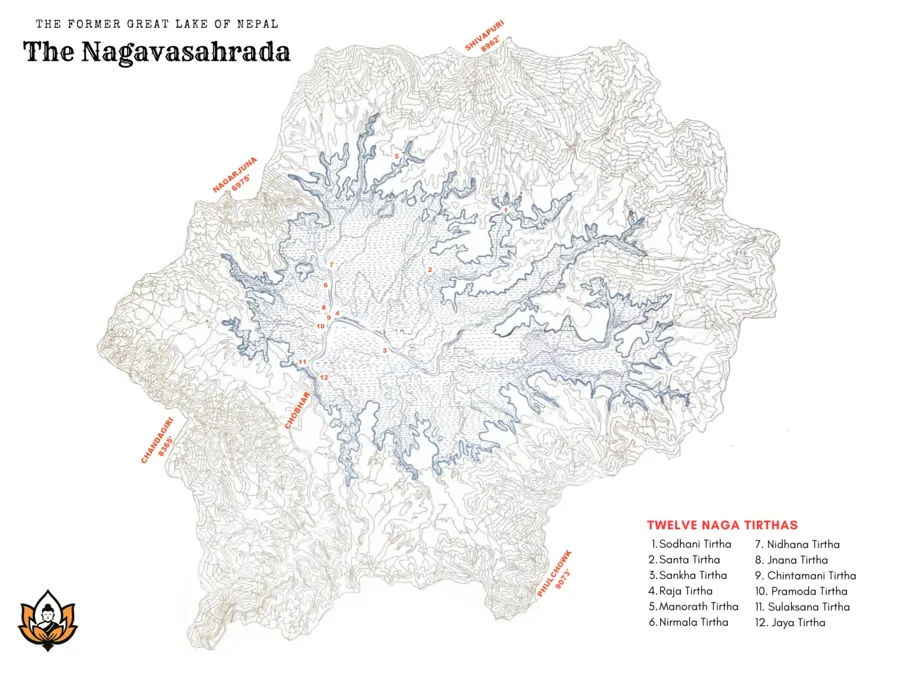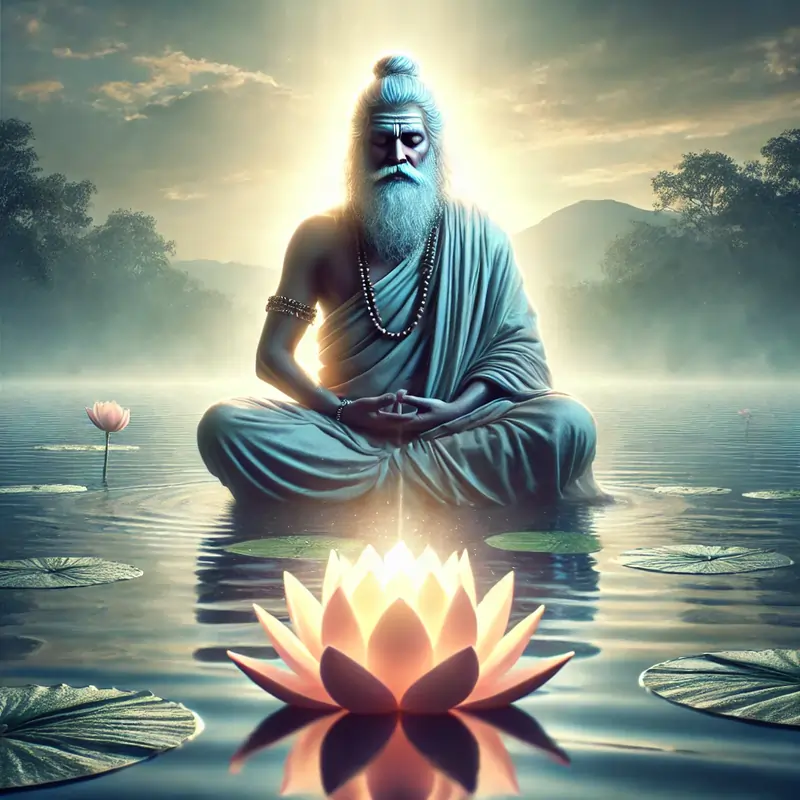Departure of Vipaswi Tathagata
After enjoying a life of eighty thousand years, Vipaswi Tathagata, the First Buddha, departed from this world. In the lineage of the Buddhas, Sikhi Tathagata, in Sanskrit सिखी तथागत, the Second Buddha, emerged to illuminate the path of Dharma and protect all sentient beings. During those days, the lifespan of human beings was 70,000 years. It was the time period when Shakyamuni Buddha was born as bodhisattva named Ksemakara (क्षेमाकर). He is said to have lived in a region known as Aruna, possibly corresponding to the Arun Kosi region of eastern Nepal or Arunavati region in Maharashtra of India.
The Earthquake and Its Divine Cause
One day, as Sikhi Tathagata was giving a profound lecture in his Vihara about the mysteries of the past, present, and future, an unusual event occurred, a great quaking of the earth. This sudden tremor startled his disciples, filling them with curiosity and a touch of fear. Unable to comprehend the cause, they turned to their teacher, pleading to understand the reason behind the phenomenon.
Sikhi Tathagata, in his infinite wisdom, explained that in the north, atop the mighty Himalayas, lies a sacred lake called Nagavasahrada. This lake is not an ordinary body of water but a holy site revered by all Buddhas and Bodhisattvas. Its spiritual significance stretches back through time itself.
Long ago, Vipaswi Tathagata, another enlightened being, visited this divine place. In his wisdom, he planted the tuber root of a lotus within the sacred waters of Nagavasahrada. Over the ages, this lotus has grown into a magnificent flower, boasting a thousand radiant petals.
Now, something extraordinary is unfolding. At the heart of this blossoming lotus, Swayambhu Dharmadhatu has emerged—a divine manifestation of dazzling brilliance, exuding light that transcends the boundaries of the physical world. This sacred phenomenon has drawn the attention of divine beings from all corners of the universe.
Gods from every direction have gathered to worship this miraculous occurrence. Even Sesa Naga, the great serpent who is believed to uphold the universe, has joined in this celestial celebration to pay homage to Swayambhu Dharmadhatu.
The collective energy of these divine beings, their reverence, and the waves of celebration have sent ripples of joy and power through the cosmos. It is this overwhelming spiritual activity that has caused the earth to quake.
With these words, Sikhi Tathagata calmed his disciples, revealing that the earthquake was not a cause for fear but a sign of divine celebration, a moment to reflect on the interconnectedness of the spiritual and physical realms. The event reminded everyone present of the grandeur of the universe and the sacred forces that influence even the seemingly mundane tremors of the earth.
The Symbolism of Swayambhu Dharmadhatu
Sikhi Tathagata explained that Swayambhu Dharmadhatu represented the reality of self-creation. Its symbolism was expressed through the five Dhyani Buddhas, who were ideal Buddhas visualized during meditation.
The Dhyani Buddhas were compared to the petals of a lotus, which symbolized the unfolding nature of Dharmadhatu. They were also likened to the different colors formed when sunlight passed through a prism, representing the spiritual differentiation of the Dharmadhatu.
Each Dhyani Buddha was said to embody a specific direction and spiritual quality:
- Aksobya in the East,
- Ratnasambhava in the South,
- Amitabha in the West,
- Amoghasiddhi in the North, and
- Vairochana in the Center.
The Dhyani Buddhas were regarded as symbolic of the spatial expansion and spiritual manifestation of Dharmadhatu.
Swayambhu Dharmadhatu was described as the spiritual house for all Buddhas and Bodhisattvas. It was considered a great honor of the present time that such a shrine existed in the sacred lake of Nagavasahrada. Through this sacred symbol, the interconnectedness of the spiritual and physical realms was highlighted, offering a profound message to all who sought enlightenment.
Pilgrimage to Swayambhu
According to different editions of Swayambhu Purana, different versions of the story were shared about Sikhi Buddha and the pilgrimage to Swayambhu Dharmadhatu. Each version revealed unique events, but all emphasized the sacredness of the site and its significance in achieving enlightenment.
Version 1:
Sikhi Tathagata, along with his disciples, undertook a pilgrimage to the holy lake where Swayambhu Dharmadhatu resided. A circumambulation of the lake was performed, after which the group meditated on the peak to the southwest of the valley, known as Dhyanochcha (currently called Chandagiri).
While meditating, Sikhi Tathagata declared to his disciples that he would dissolve himself within the Swayambhu Dharmadhatu to achieve instant enlightenment. This act symbolized the unification of his physical form with the spiritual realm. Through meditation, he was incorporated into the Dharmadhatu, achieving enlightenment and leaving his physical body. His disciples, inspired by this profound event, devoted themselves to the Swayambhu shrine.
Version 2:
A follower of Sikhi Buddha named Ratnapani Bodhisattva expressed a desire to visit Swayambhu and worship the Dharmadhatu through hymns and prayers. Permission was granted by Sikhi Buddha, who encouraged the visit, stating that worship and meditation at Swayambhu Dharmadhatu would lead to instant enlightenment and ultimate knowledge.
Ratnapani Buddha, along with other Mahasattvas, Bodhisattvas, and disciples, journeyed to Swayambhu. Upon arrival, the group worshipped the Swayambhu Dharmadhatu with prayers, hymns, and Dharani mantras. Their devotion was expressed with great enthusiasm and reverence, marking the pilgrimage as a deeply spiritual experience.
Version 3:
In a third version, Sikhi Buddha, accompanied by Ratnapani Buddha and his disciples, visited the holy lake where Swayambhu Dharmadhatu was situated. They circled the lake and meditated at Dhyanochcha (Chandagiri). Sikhi Buddha worshipped and prayed to Swayambhu Dharmadhatu, offering deep spiritual reverence. After completing their meditation and worship, Sikhi Buddha and the Bodhisattvas returned to Anura and resumed their spiritual practices at the monastery.
In each version, the pilgrimage to Swayambhu Dharmadhatu was described as a sacred journey, symbolizing devotion, meditation, and the path to enlightenment. The stories illustrated the spiritual significance of the site and its transformative power for those who worshipped there.

Swayambhu Purana – Table of Contents
« Chapter 2: Vipaswi Tathagata: Origin of Swayambhu
Chapter 4: Vishwabhu Tathagata: Manjushri and Birth of Nepal Valley »

